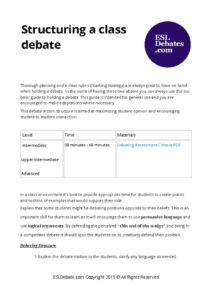Thorough planning and a clear debate rubric (marking strategy) are always great to have on hand when holding a classroom debate. In the event of having these two absent, you can always use our basic guide to holding a debate. This guide is intended for general use and you are encouraged to make adaptations where necessary.


♦ Download this entire lesson plan as a PDF file.
♦ Download the debating Assessment Criteria PDF
This debate lesson structure is aimed at maximising student opinion and encouraging student to student interaction.
| Level | Time | Materials |
| Intermediate
Upper-Intermediate Advanced |
30 minutes – 60 minutes
|
Debating Rubric PDF
|
In a class environment, it’s best to provide appropriate time for students to create points and to think of examples that would support their side.
Explain that some students might be debating positions opposite to their beliefs. This is an important skill for them to learn as it will encourage them to use persuasive language and use logical arguments. By defending the perceived “thin end of the wedge” and being in a competitive debate it should spur the students on to creatively defend their position.
Debating Structure
- Explain the debate motion to the students, clarify any language as needed.
- Present students with additional material to formulate ideas. Magazine articles, Ted Talks, statistics or any other material will work well; allow for time and extra activities. Be sure to present both sides of the motion so that each position in the debate can defend themselves with confidence and rigor. (15 minutes +)
- Print off a copy of the debate rubric PDF and give each student one copy. Explain the required skills and how to be a fair judge. You can also create your own criteria if needed. Alternatively, the audience can be judges or assign students to assess a classmate anonymously and after the debate swap papers.
- Present the debating plan
- The whole class votes on the motion. They are free to vote as they please and the points are tallied. (1 minute)
- Teams are formed; students select one student to be the opening speaker whose role is to briefly present their position. Opening speakers speak for 2 minutes. (allow prep time and presentation time 8 minutes)
- Each team member can speak for a maximum of 3 minutes and then must relent to an opposing member. Debate continues turn-by-turn until each member has spoken at least once and that a majority of debate points have been used up. (20 minutes)
- Optional pause here for the further development of ideas for rebuttal.
- Cool down period. Use a few moments to highlight the key ideas and what were the most influential moments in the debate. (5 minutes)
- Allow time for extra free debate where students are not bound to their team. (5 – 10 minutes)
- The final vote, students can vote again and another tally is taken. Compare results with the first vote and take time to discuss, why was there or was there not a change? (5 minutes)
- Final task. Students can have a writing activity where they explore their own thoughts on the subject and reflect on their experiences. (10 minutes)
Using this Oxfordesque debating structure gives plenty of time for students to create ideas and to use them in the classroom. I have found that students often engage more in a debate when a prize is involved. So, you can naturally pair this with further vocabulary and proceed to give students points for each use of the phrase or vocab.
Now that you have a working debate structure feel free to make changes as needed and adapt to the student level.

